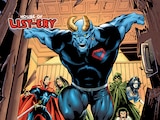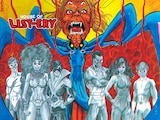One of the many things that sets Aquaman apart from his fellow Justice Leaguers is the role that animals play in his adventures. Yes, Arthur Curry is the ruler of Atlantis, but he also has the ability to communicate with any sea creature. Because of this, Aquaman comics—along with many a Saturday morning cartoon—have cleverly explored this this power and aspect of his personality for decades now. In this week’s DC House of List-ery, let’s take a look at a few stories that feature clever use of some of Aquaman’s animal allies.

1) Adventure Comics #232 – “Aquaman Joins the Navy”
In the early years of Aquaman’s publication history, he pulled a lot of stunts. In Adventure Comics #120, he was in a story called “Aquaman Goes to College.” Later on, in Adventure Comics #232, Arthur decides to join up with the navy after being recruited by them.
Near the start of the issue, Aquaman can be seen riding around on “his trusted sea steed”—the octopus named Topo. Topo is one of Arthur’s closest allies during this period, frequently coming to his aid. The octopus has even played musical instruments for him—including in 2018’s Aquaman film. As it turns out here, having an octopus for a buddy is immensely helpful on a busy navy ship. Arthur calls on several more octopods to come aboard and help with scrubbing and mopping the deck. They even help clean the ship’s dirty dishes.

2) Aquaman #23 – “The Birth of Aquababy”
Being able to communicate with all sea animals is a massive boon for Aquaman, considering how vast the ocean is. In 1965’s Aquaman #23, this power saves the life of both his wife Mera and their unborn son, Aquababy. When Mera finds out she’s pregnant, she’s also informed that both her and the baby are at risk of dying because of a “rare malady” Aquaman’s family is cursed with. The only way to save both Mera and Aquababy’s lives is with a special serum from a remote part of the ocean.
Aquaman and Aqualad hurry to find the serum. But once they do, they get caught in the blast of an underground volcano, knocking them out. Shortly before losing consciousness, Aquaman communicates with a nearby octopus, passing the serum to it and telling it that the bundle needs to get to Mera. The octopus understands the assignment, and passes it off to a swordfish, who passes it off to another creature. Various sea creatures across the ocean relay serum off to each other, until a fish finally drops it in front of Mera, saving her child. This instance in Aquaman #23 remains one of the most creative and emotional uses of Aquaman’s powers to this day.

3) Aquaman #38 – “‘Justice is Mine,’ Saith the Liquidator”
A king such as Aquaman needs a faithful horse, and that horse’s name is Storm.
Storm is a giant seahorse that Aquaman rides around on underwater, often when he’s with Aqualad, who has his own aquatic steed named Imp. 1968’s Aquaman #38 features an extended chase sequence where Aquaman, atop Storm, tries to outrun a villain known as the Liquidator. Aqualad, riding Imp, chases after him, only to get knocked off of Imp. This story really shows off the unique genre blend of Silver Age Aquaman, as it brought together fantastical sci-fi elements with the sort of chase scenes popular in Western movies of the time.

4) Aquaman #48 – “How Aquaman First Got His Powers!”
As the Silver Age of Comics wore on, fans came to wonder how Aquaman’s powers first manifested. This was addressed in 1969’s Aquaman #48, which expanded on Aquaman’s origin first told in Adventure Comics #260.
A backup story details how Aquaman gained control over his animal telepathy as a child. While swimming, he came across a squid who was pinned under an old sunken Roman galley. Wanting to help the creature, he communicated with a nearby group of octopods, asking them to row the oars. Freeing the squid soon spread the word to the other sea creatures that young Arthur was a friend to them, eventually allowing him to command all sea life.

5) Aquaman Annual #3 – “Tusk ’Til Dawn”
An old ally of Aquaman’s who has fallen to the wayside in recent times is Tusky the walrus. He made occasional appearances during Aquaman’s Silver Age comics, but it wasn’t until he resurfaced in 1997s Aquaman Annual #3 that things started to get interesting.
In a pulp-influenced story by Peter David, Marty Egeland and Howard M. Shum, Aquaman is paid a visit by Tusky’s wife, who begs him to find her missing husband. Arthur eventually acquiesces to Mrs. Tusky’s demands, and his search for his old pal leads him to a waterpark where Tusky is living a life happily entertaining tourists. When Arthur confronts his friend about why he hasn’t returned to his wife, Tusky acknowledges that he and Mrs. Tusky have different things they want out of life. Tusky feels that he was born to be a performer. In the end, Aquaman leaves, respecting his friend’s wishes.
Aquaman Annual #3 merges the zanier parts of Aquaman’s comic book history with a self-aware sense of humor, showing that even in our more modern age of serious superheroes, Aquaman’s fishy friendships endure.
Jules Chin Greene writes about comics for DC.com, and his work can also be found at Nerdist, Popverse and Multiverse of Color. You can follow him on Twitter and Bluesky at @JulesChinGreene.
NOTE: The views and opinions expressed in this feature are solely those of Jules Chin Greene and do not necessarily reflect those of DC Entertainment or Warner Bros., nor should they be read as confirmation or denial of future DC plans.















